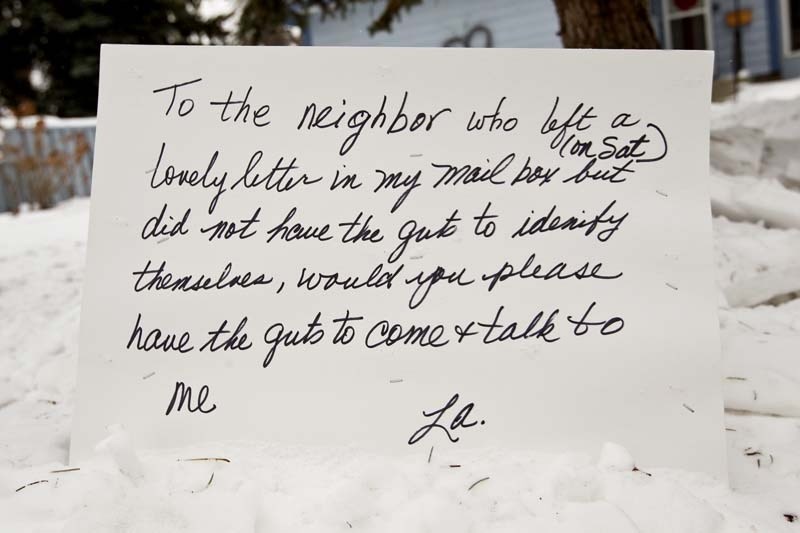If you have a concern about Laura Anderson’s sidewalk snow removal, you should talk to her directly rather than put an anonymous letter threatening an injury lawyer in her mailbox.
“I don’t like being threatened,” said Anderson.
Anderson, who lives along Fenwick Crescent, and a handful of other nearby homes received an anonymous, type-written letter last week. The letter, which is written in all-caps and unsigned, says the writer “would like to respectfully remind, or make you aware” of the city’s snow removal requirements.
The letter asks the “neighbor (sic)” to “be diligent and promptly remove snow and ice.
“Failure to do so will result in a call to bylaw … please note, should a fall resulting in loss of health, work, wages, or any other detrimental condition, an injury lawyer will contact you,” it says.
Anderson has been trying to figure out where the letter came from. She cleaned out her mailbox late last Friday afternoon, but the letter was in the box when she went out to get her copy of the Gazette on Saturday.
She’s been showing it to her neighbours, asking around.
“Anyone that I’ve talked to, they were horrified,” Anderson said. In addition to the letter her ice chipper has gone missing in recent weeks.
If someone has a problem with her shovelling, she’d prefer they came and spoke to her directly. She pointed out if some don’t think clearing is happening fast enough, they should speak to the occupants to find out why – some in the area are older people, she noted, while at her house, she has had back surgeries and her husband has a spinal condition.
“Once it stops snowing I’m out there cleaning and doing the best I can,” Anderson said. She has put up a sign on her lawn in response to the letter’s author.
Anderson said she doesn’t clean it down to the concrete, noting snow can offer more traction than bare concrete in case of ice.
That’s something that’s actually okay under the city’s community standards bylaw, under which snow removal falls.
Peace officer program supervisor Stu Fraser said he’s encountered many people who think there’s a bare sidewalk requirement.
“But that’s not true,” he said, adding that snow can have more traction in some weather conditions than cleared concrete.
The bylaw calls for people to “maintain any sidewalk adjoining and adjacent to land they own or occupy and clear of any dangerous condition caused by snow or ice within 48 hours from which the dangerous condition was formed.”
Fraser said the expectations of what that 48 hours is counted from varies depending on the weather condition. If there’s a complaint about snow accumulation, they generally count from the end of the storm, he said. But in the case of dangerous conditions like ice people might have to go out and address the problem even while the weather condition is still ongoing.
“It’s treated differently depending on whether it’s a total accumulation of snow or whether it’s an unsafe walking condition,” Fraser said.
The community standards bylaw is listed on the city’s website and is Bylaw 12/2010. The bylaw quoted on the letter handed out to Anderson and other residents incorrectly quotes Bylaw 18/2005.
Fraser said enforcement usually is prompted by way of complaints, but before issuing a fine the bylaw officers will often try and educate the offending home’s occupants first.
“If we get somebody who proves to be unco-operative we have in the past made arrangements with public works to go in and have their sidewalks cleared and the costs associated with that can be added to the tax roll of the homeowner. But we’ve had pretty good success with educating and asking people to comply,” Fraser said.
As for who left the letter, it’s unclear if it was a neighbour or someone else.
A supervisor at the Canada Post distribution centre in St. Albert said it wouldn’t have been them, as any communication would have been done on formal letterhead.
Gazette reader services regional co-ordinator Lori McNabb noted any communication from this paper would have been done within the paper itself. In fact, an ad reminding people to please clear their sidewalks and driveways has been running recently.
“We definitely did not do this,” McNabb said. “We wouldn’t authorize something like this.”
Utility checkers, generally, do not visit homes anymore. Most metre reading is done via wireless device from the street.




